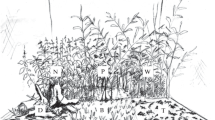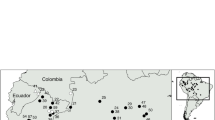Abstract
Four adultTarsius bancanus were followed for a total of over 120 hrs in Sepilok Forest Reserve, Sabah, using radiotracking techniques. Seven hundred and twenty-two records of locomotor and postural behaviour were gathered.Tarsius bancanus travels a mean of 1,800 m per night, over large (4.5 to 11.25 ha) ranges. They move at a mean height of 0.89 m, utilizing primarily vertical sapling trunks of diametre 2 to 4 cm. Lateral movement is carried out largely by leaping.Tarsius were found on the ground in 5.3% of cases, but movement on the ground is very largely restricted to short investigative movements by walking. Climbing is mostly related to foraging behaviour and characteristically occurs on relatively small supports.Tarsius bancanus' locomotion is similar to, but more specialized than that ofT. spectrum, Galago alleni, andGalago senegalensis, all of which have rather similar patterns of habitat utilization. We suggest that the energetic constraints of small body size together with the need to patrol large home ranges may have lead both toTarsius bancanus extreme degree of locomotor specialization and to its exclusive animalivory.
Similar content being viewed by others
References
Bearder, S. K. &R. D. Martin, 1980. The social organization of a nocturnal primate revealed by radio-tracking. In:A Handbook on Biotelemetry and Radio Tracking,D. W. MacDonald &C. J. Amlaner,Jr. (eds.), Pergamon Press, Oxford, pp. 633–648.
Charles-Dominique, P., 1977.Ecology and Behaviour of Nocturnal Prosimians. Duckworth, London.
Crompton, R. H., 1980.Galago Locomotion. Unpub. Ph.D. dissertation, Harvard Univ., Cambridge, Massachusetts.
————, 1982. Age differences in locomotion of two subtropicalGalaginae.Primates, 24: 241–259.
————, 1984. Foraging, habitat structure and locomotion in two species ofGalago. In:Adaptations for Foraging in Nonhuman Primates.P. Rodman &J. Cant (eds.), Columbia Univ. Press, New York, pp. 73–111.
---- &P. M. Andau, in press. Ranging, activity rhythms, and sociality in free-rangingTarsius bancanus. A preliminary report.Intern. J. of Primotol.
Davis, D. D., 1962.Mammals of the Lowland Rain-forest of North Borneo. Bulletin of the Singapore National Museum 31.
Fogden, M., 1974. A preliminary field-study of the western tarsier,Tarsius bancanus Horsfield. In:Prosimian Biology,R. D. Martin,G. A. Doyle, &A. C. Walker (eds.), Pittsburgh Univ. Press, Pittsburgh, pp. 151–165.
Garber, P., 1984. Use of habitat and positional behavior in a neotropical primate,Saguinus oedipus. In:Adaptation for Foraging in Nonhuman Primates,P. Rodman &J. Cant, (eds.), Columbia Univ. Press, New York, pp. 112–133.
Harcourt, C. S., 1980. Behavioural adaptations in South African galagos. Unpub. Ph.D. dissertation, Witwatesrand Univ., Johannesburg.
———— &L. T. Nash, 1986. Species differences in substrate use and diet between sympatric galagos in two Kenyan coastal forests.Primates, 27: 41–52.
MacKinnon, J. &K. MacKinnon, 1980. The behavior of wild spectral tarsiers.Int. J. Primatol., 1: 361–379.
Niemitz, C., 1979a. Results of a field study on the western tarsier (Tarsius bancanus borneanusHorsfield, 1821) in Sarawak.Sarawak Mus. J., 48(NS): 171–228.
————, 1979b. Outline of the behaviour ofTarsius bancanus. In:The Study of Prosimian Behaviour,G. A. Doyle &R. D. Martin (eds.), Academic Press, New York, pp. 631–660.
————, 1985a.Biology of Tarsiers. Gustav Fischer, Stuttgart.
————, 1985b. Synecological relationships and feeding behaviour of the genusTarsius. In:The Biology of Tarsiers.C. Niemitz (ed.), Gustav Fischer, Stuttgart, pp. 59–75.
————, 1985c. Activity, rhythms and use of space in semi-wild bornean tarsiers, with remarks on wild spectral tarsiers. In:Biology of Tarsiers,C. Niemitz (ed.), Gustav Fischer, Stuttgart, pp. 85–115.
————, 1985d. An investigation and review of the territorial behaviour and social organization of the genusTarsius. In:Biology of Tarsiers,C. Niemitz (ed.), Gustav Fischer, Stuttgart, pp. 117–127.
————, 1985e. Vocal communication of two tarsier species (Tarsius bancanus andTarsius spectrum). In:Biology of Tarsiers,C. Niemitz (ed.), Gustav Fischer, Stuttgart, pp. 130–141.
————, 1985f. Locomotion and feature ofTarsius bancanus. In:Biology of Tarsiers,C. Niemitz (ed.), Gustav Fischer, Stuttgart, pp. 191–225.
Poorman, P. A., M. Cartmill, R. D. MacPhee &M. J. Moses, 1985. The G-banded karyotype ofTarsius bancanus and its implications for primate phylogeny.Amer. J. Phys. Anthropol., 66: 215.
Reason, R. C., 1978. Support use behavior in Mindanao tarsiers (Tarsius syrichta carbonarius).J. Mammal., 59: 205–206.
Author information
Authors and Affiliations
About this article
Cite this article
Crompton, R.H., Andau, P.M. Locomotion and habitat utilization in free-rangingTarsius bancanus: A preliminary report. Primates 27, 337–355 (1986). https://doi.org/10.1007/BF02382075
Received:
Accepted:
Issue Date:
DOI: https://doi.org/10.1007/BF02382075




